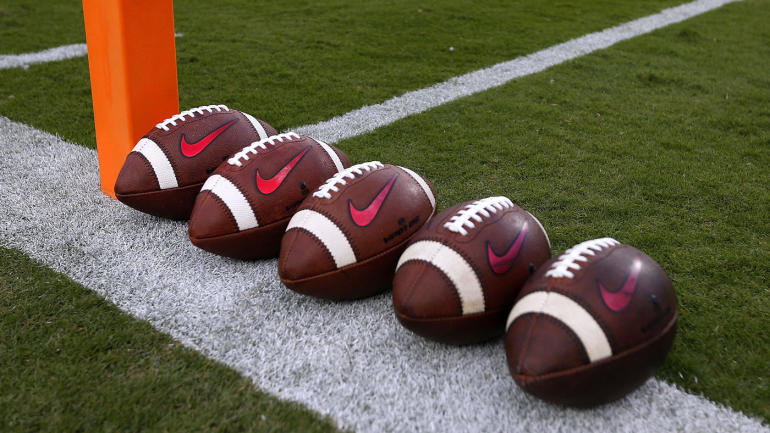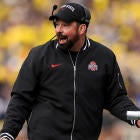
If Jake Spavital isn't wheelin', he's dealin', all within the transfer portal. It is an accepted way of life these days for the 36-year-old Texas State coach.
"I feel like I'm back in those SEC recruiting battles," said the man who was Johnny Manziel's quarterbacks coach the year he won the Heisman Trophy in 2012 at Texas A&M.
While others are bemoaning the transactional nature of the portal, roster management and the new one-time transfer rule, Spavital has embraced all of it. More than three months after the traditional National Signing Day in February, he still has eight scholarships to offer.
The rest have gone to transfers, 11 of them. That after Spavital lost 12 players to the portal. He has not signed a high school prospect at Texas State in his Class of 2021.
Perhaps he should be called a general manager more than a coach, at least at this point.
"My whole argument is I can take the [high school] kid down the street that no one wants and no one offers who, after three years, you develop him into a good player, and he can leave," Spavital said. "Or you can [go to the portal]."
The unprecedented freedom players are experiencing has forced coaches into making the same hard decisions as Spavital. What's the best way to assemble a roster going forward?
Transfers are more or less a known commodity who are more or less locked into a roster spot. (Players can transfer a second time in a career but would require an NCAA waiver for immediate eligibility.)
"The hot topic is less and less high school kids are going to get recruited," Memphis coach Ryan Silverfield said. "If you're going to offer a kid who's a good player in high school and can transfer in two years [versus] getting a 'better' [transfer] player who can't leave you …"
Silverfield didn't have to finish his thought, but the implication is obvious. Coaches are roster managers first before it comes to calling plays. Those who don't adapt will be left behind.
We've already seen it at Alabama where Nick Saban may have turned the SEC in his favor (again) by plucking Tennessee linebacker Henry To'to To'to and Ohio State wide receiver Jameson Williams out of the portal this offseason.
That's certainly the case at the other end of FBS for Spavital, who is 5-19 in two seasons.
"That is what are we trying to do especially in a time when, [if] you don't win, you get fired," he said. "Instead of waiting around, it's given life to our program. We gotta think outside the box here."
Something similar can be said of the 129 other FBS programs. The new recruiting climate has forced coaches to deal with the present first and worry about the consequences later.
The average FBS team has lost 11 players to the portal. Factor in the usual injury attrition, and coaches are already predicting thin rosters before the NCAA can step in with formal legislation to balance things out. The earliest that's likely to come is the fall of 2022.
Until then?
"I don't think we know the answer because we don't know all the questions," said Tulane athletic director Troy Dannen, a member of the NCAA's Football Oversight Committee that could eventually develop legislation.
There is a yearly limit of 85 scholarship players for FBS teams. However, a program may sign only 25 per year. Rosters are in flux as coaches decide whether the portal is a gift or a curse -- or maybe both. So-called "super seniors" aren't counted against the 85 this season as they were allowed an extra year of eligibility in 2021 due to COVID-19. They also could leave giant holes in rosters after they leave after this season.
"They kind of mask some of your issues," Cincinnati coach Luke Fickell said. "If you have six super seniors, so you're really not under the limit, but when those guys leave you've going to have an even bigger issue."
Coaches in Fickell's AAC are already in favor of expanding annual scholarship limits from 25 to 30 as a stop gap. A blanket waiver to surpass that 25-scholarship limit for at least one year has been discussed in coaching circles. The Big 12 and MAC proposed a two-year scholarship limit of 50, spread out any way a coach wants. That was shot down. The possibility of allowing an extra scholarship for every player lost to the portal -- the so-called "one-for-one" approach -- isn't likely.
Chaos goes only so far.
For now some coaches are awarding scholarships to walk-ons to shore up rosters. While that may be the decent thing to do with surplus scholarships, it doesn't necessarily improve the overall talent level on the team. Imagine, then, coaches running off current high school recruits when something better appears in the portal. It's apparently happening.
"I've watched a lot of coaches out there be like, 'We're not going to do the portal.' Then they commit up [to the limit] with high school kids and they actually cut high school kids [from their recruiting classes]," Spavital said. "I'm saying I think it's all the wild, wild West."
Meanwhile, there is anecdotal evidence of players who entered college in January already in the portal.
"They've lasted five months," Silverfield said. "Whether it's a new coach or they don't like the structure."
MAC commissioner Jon Steinbrecher is the so-called "father of the one-time transfer". He began advocating for the player freedom we have before us since 2015.
"It's going to be challenging to catch up, but we've known that for five years," Steinbrecher said. "You get down to 70-something kids, 60-something kids you can't catch up. That needs to be addressed."
There is the looming prospect of the Academic Progress Rate. The APR is an annual measure of team academic achievement. Those teams that fall below the standard can receive a postseason ban. It's one of the biggest hammers the NCAA can deliver.
Due to COVID-19, the NCAA Board of Directors in October suspended APR penalties for two years. With the added revolving door for transfers, will the APR simply be removed as a tool altogether?
If so, then what for the NCAA's constantly diminishing ability to oversee the collegiate model?
Dannen predicted a "blood bath" in roster management in the next coaching change cycle. Since 2017, there have been 90 coaching changes, an average of more than 22 per year. Over 60% of FBS have made at least one switch during that time.
"Let's say Willie Fritz left," Dannen said of the Green Wave's successful coach going into his sixth season. "Our roster is the best it's ever been. It will be like buzzards are circling around to pick off our 10 best kids. They can go place someplace else right away. I can't catch up [on roster size] with those kids [leaving]. Then the next coach comes in, and you're going to lose another 10."
Several conferences last season adopted 53 as a minimum roster size to play during COVID-19. That was more or less an emergency adaptation to get games in, but it was not ideal. With several coaches once again operating on the edge given their roster size, the problems are different. The frustration is clear.
Silverfield is proud of his program having found two-star receiver Tahj Washington out of Marshall, Texas, two years ago. As a redshirt freshman in Silverfield's first season as coach, Washington was the Tigers' No. 2 receiver and named a freshman All-American.
In March, he transferred to USC.
"It's not the same game," New Mexico State coach Doug Martin said. "It's harder to develop players. At our level [in the Group of Five], you're not going to get the finished product. We had a defensive lineman who transferred to Arizona. He got taken in the sixth round. We'll become a feeder system for other people."
Spavital sees it the other way. Among his incoming transfers is Liam Dobson, a 340-pound FCS All-American offensive lineman from Maine. Dobson is a ready-made starter for Texas State having already been drafted No. 3 overall by the Canadian Football League. His quarterback is former Elite 11 talent Ty Evans from NC State.
"I think these are all calculated risks," Spavital said. "If I was a Power Five [team], I would have a pretty good mix of high school kids. We made as many offers in the state of Texas as the other teams in Texas. Unfortunately, we haven't won enough games and no one wants to commit to us out of high school."
The one-stop shopping aspect of the portal has led to the real possibility high school players will actually be overlooked in recruiting. Spavital said he has three yet-unannounced high school commits that would count in the Class of 2021.
"We're telling them to keep it quiet and make it public later," he said. "Who knows what's going to happen?"
Meanwhile, there are approximately 2,500 FBS players in the transfer portal despite there only being a few hundred scholarships available at this point, according to reports. That imbalance is not likely to change anytime soon. Juniors leaving early for the NFL certainly haven't figured it out. About 30% of them don't even get drafted on average.
Coaches can talk all they want about players thinking twice and getting advice before transferring. The portal is a tool at their disposal, not a counseling center. Adding to the confusion, on June 1, coaches for the first time will be able to work out prospects following 15 months of the recruiting dead period due to COVID-19.
There will literally be tryouts on college campuses with JUCOs, unsigned high school players, walk-ons and those uncommitted transfers answering the cattle call. Remember, Spavital has those eight schollies to give.
We're way beyond coaches asking, "Am I going to have to change the way I coach?" In the one-time transfer era, the answers are varied. Yes? No? Maybe? Depending on the program, those answers might all be correct.
"If a player walks up and is on my team and does something wrong, and I say, 'That's not right I'm going to suspend you.' Before I even have a chance, he pushes a button [and is in the portal]. It's on social media before it even gets to my phone," Silverfield said.
"I've known a lot of coaches who have thrown players off, suspended players or kids gotten in legal trouble. Their fans are getting on them for losing players. Meanwhile, aren't they supposed to hold kids accountable?"
Character, of course, is a huge issue. Any coach will remind you there's always a reason for pause when a player is in the portal. But for every coach who questions a transferring player's loyalty or makeup, there is always one who will gladly go into the portal to fill a need.
"What we've learned is you don't want to take Group of Five players out of the transfer portal," Martin said. "It started off [with] the guys that were leaving us we were asking, 'Would you want them back?' The answer was, really, 'No.' Most of them that had left, they weren't really FBS players or they were character problems. Then we started looking at Group of Five transfers. Did they pan out? And they really didn't."
Coaches at least have that leverage over incoming one-time transfers. They've got experience, and they can't go anywhere once joining the program without sitting out a year-in-residence.
On the other end, Northern Illinois AD Sean Frazier has thought deeply about the concept of "rerecruiting". That is, maintaining a close relationship with individual players sometimes on a daily basis. The risk of ignoring those relationships can be a trip to the transfer portal.
Frazier already has his mind on three retired coaches that he wants to bring in to speak to his players: Steve Spurrier, Bill Curry and Barry Alvarez.
"The whole concept of the Ol' Ball Coach saying, 'You're here and you're going to do it may way,' that's changed over time," Frazier said. "The only way to get really away from that is to win all the time and people just love you."
So if you're not Alabama, Clemson or Ohio State, you've got a similar rerecruiting issue? Not for Spavital. The door is always revolving.
"I get put in these situations where I can't say no to kids [in the portal]," Spavital said. "It's great for ol' Texas State right now."





















